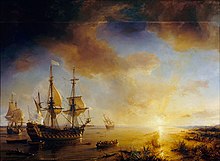Jean L'Archevêque
[2][3][4] While Duhaut was killed by expedition members to avenge La Salle's murder, L'Archevêque escaped the same fate because he was viewed more favorably and was thought to be less guilty.
[7] In 1684, aged twelve, L'Archevêque joined the expedition of René-Robert Cavelier, Sieur de La Salle.
[8] La Salle returned to France and proposed establishing a French colony at the mouth of the Mississippi, between Spanish Florida and New Spain.
[9] The colony would provide a base for promoting Christianity among the native peoples as well as a convenient location for attacking the Spanish province of Nueva Vizcaya and gaining control of its lucrative silver mines.
[11][12] Fifty-eight days later,[12] the expedition stopped at Santo Domingo (Saint-Domingue), where one of the ships, the St-François, which had been fully loaded with supplies, provisions, and tools for the colony, was captured by Spanish privateers.
[14] The Duhauts were then given trading privileges and allowed space for merchandise on La Salle's ships that would have ordinarily been reserved for supplies for the colony.
[17] For several days the men attempted to salvage the tools and provisions that had been loaded on the Aimable, but a bad storm prevented them from recovering more than food, cannons, powder, and a small amount of the merchandise.
[21] La Salle searched for a more permanent settlement site and found Garcitas Creek, which had fresh water and fish, with good soil and timber along its banks, and named it Rivière aux Boeufs for the nearby buffalo herds.
[27] The destruction of their last ship left the settlers stranded on the Texas coast, with no hope of gaining assistance from the French colonies in the Caribbean.
[28][29] La Salle believed that their only hope of survival lay in trekking overland to request assistance from New France,[27] and sometime that month he led a final expedition to attempt to reach Illinois.
The following day, La Salle was shot by Pierre Duhaut while speaking to L'Archevêque as he was approaching the camp to investigate his nephew's disappearance.
[28] Infighting led to the deaths of two other expedition members, including Pierre Duhaut, within a short time, and L'Archevêque was targeted but was spared at the insistence of the Recollect friar Father Anastasius Douay.
They reached France in summer 1688 and informed King Louis of La Salle's death and the horrible conditions in the colony.
In the summer of 1689, they sailed with Captain Andrés de Pez as prisoners to Spain, and arrived in Madrid in January 1690.
However, the war council also could not recommend keeping then isolated in royal jail while at peace with France because Louis XIV would have had grounds for their repatriation.
[38] After swearing an oath to Spain, the war council allowed the men to return to Spanish territory controlled by the Viceroy of New Spain Gaspar de la Cerda Sandoval Silva y Mendoza, 8th conde de Gelves, where they would be out of reach of the French, and granted them an additional stipend and a soldier's rations for the voyage.
[38][39] L'Archevêque became a soldier then joined a group of colonists led by Diego de Vargas and arrived in Santa Fe on June 22, 1694.
The year following his marriage, L'Archevêque joined the Villasur expedition to investigate suspected French influence among the Pawnee in the present state of Nebraska.
His trading operations extended as far as Sonora with occasional business in Mexico City, and his notes of credit were accepted and endorsed by those connected to the government.

